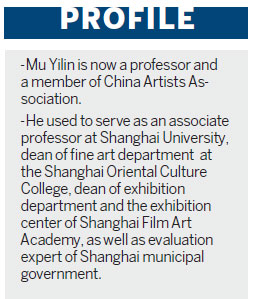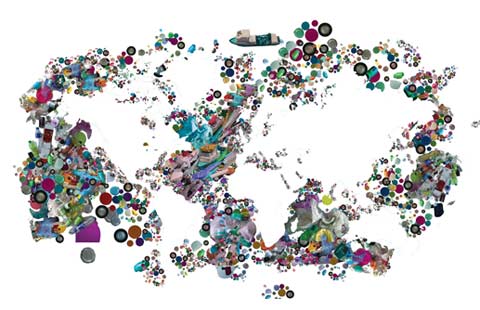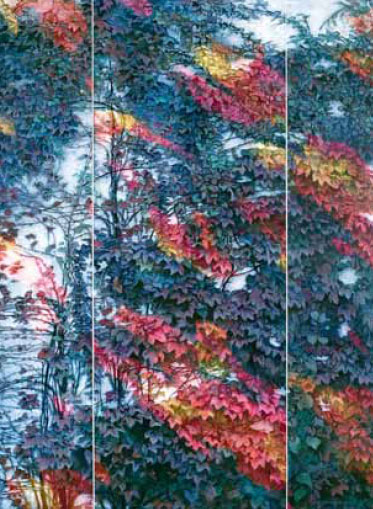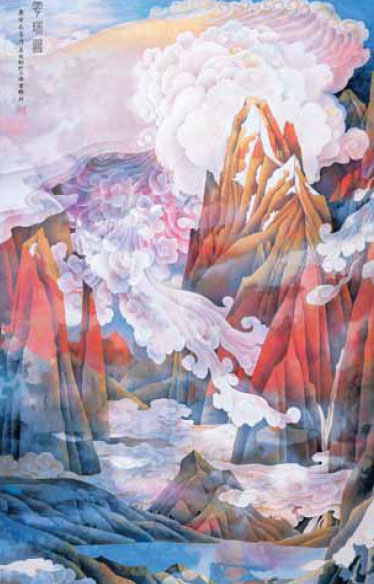Vibrant works challenge traditional notions of paintings
Updated: 2014-05-16 07:15
By LI Fusheng (China Daily)
|
|||||||||||
Many people believe that Chinese paintings prioritize lines but give inadequate emphasis on color. That's unfortunately a misconception silk painter Mu Yilin has been rectifying with his resplendent works.
Be it his early painting Impression of a Lotus Pond or signature series Both Sky and Earth Are Poems, the bold, extensive use of colors, either in an abstract or concrete way, stand in stark contrast to those traditional Chinese works one typically has in mind.
Mu did not paint this way at the very start. Born in 1944, he studied traditional Chinese painting at Shanghai Fine Arts School from 1960 to 1966. Like most contemporary Chinese painters, Mu started his career by painting on the traditional medium of paper and made his name in the field when his work won first prize in a nationwide competition in 1979.
However, something happened several years later that changed his life.
In 1983, Mu observed by accident the visual effects of inks and paints on silk, which kindled his enthusiasm in the new yet traditional medium.

History has it that Chinese painters started writing and painting on silk some 3,000 years ago. The woven material had since served as the most popular medium for painters for 1,500 years, before it gradually gave way to paper during the Song Dynasty (960-1279). The replacement also made the colorless water and ink almost equivalent to Chinese painting for most foreign people.
That's why Mu made his mind to rejuvenate the art of silk painting. He has since restored a whole set of traditional skills and credited it with extraordinary atheistic values due to his pioneering moves, like painting on folded layers of silk.
Such explorations have made his works more appealing: colors are fuller and strokes are stronger.
And Mu never confines his painting to one particular school. A brief look at his works shows the realist gongbi technique, the freely expressive xieyi style, exaggerative portraits that feature folk art and some changes in shades characteristic of Impressionist works.
That is part of Mu's endeavor to improve silk painting's vitality and its ability to impress the audience. Knowing there is much room to expand the color scheme of Chinese painting, he has been exploring up and down in hopes of bringing into full play color-related emotions, rhythm and symbols in his works.
Examples include Celebrating the Spring Festival, the hues of which are evocative of happy, lucky celebrations unique in Chinese culture.
Another example is The Silk Road. Featuring cold tones, it offers an ethereal depiction of elegant and graceful Buddha and his music gods that are recurrent figures in ancient Chinese murals.
He is also introducing new skills to create patterns, including restructuring and crisscrossing everyday forms, adopting them to pursue what Chinese painters did thousands of years ago.
lifusheng@chinadaily.com.cn
|
Scared Mountain from Mu's Silk Road series. Provided for China Daily |
|
Mu has started to paint on silk since 1980s. |
|
A snapshot of Mu. |
|
Mu's painting of clouds and natural scenery. |
|
Painting with the theme on Chinese New Year. |
|
Mu's painting of lotus. |
(China Daily 05/16/2014 page18)
Today's Top News
UN chief saddened by Turkey's mine tragedy
China-Russia gas deal to be inked
2 Chinese killed in Vietnam riots
Report adds steam to Abe's ambitions
China: US must be objective about Asia tensions
July elections in Thailand 'unlikely' amid crisis
274 dead in Turkey's worst-ever mine disaster
Russia to take on active role
Hot Topics
Lunar probe , China growth forecasts, Emission rules get tougher, China seen through 'colored lens', International board,
Editor's Picks

|

|

|

|

|

|











